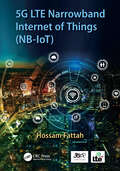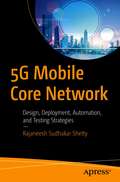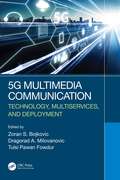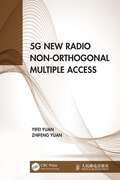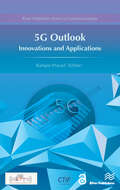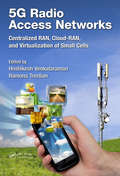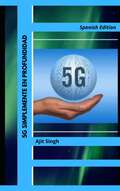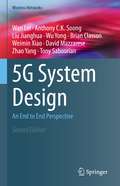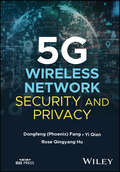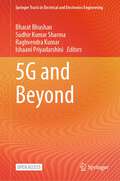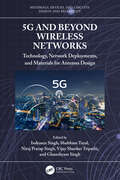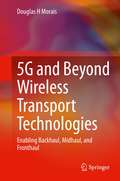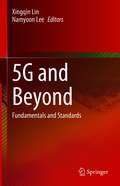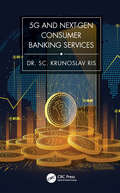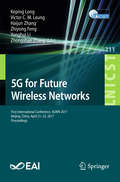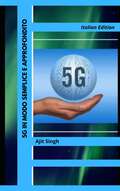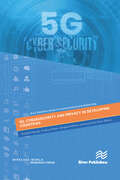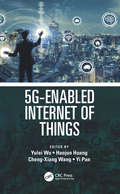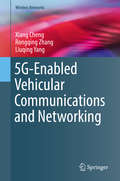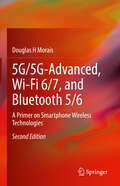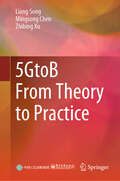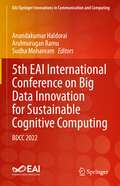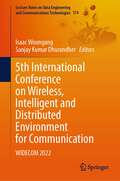- Table View
- List View
5G LTE Narrowband Internet of Things (NB-IoT)
by Hossam FattahThis book explains the 3GPP technical specifications for the upcoming 5G Internet of Things (IoT) technology based on latest release which is Release 15. It details the LTE protocol stack of an IoT device, architecture and framework, how they are functioning and communicate with cellular infrastructure, and supported features and capability. NB-IoT is designed to connect a large number of devices in a wide range of application domains forming so-called Internet of Things (IoT). Connected devices are to communicate through cellular infrastructure. This technology is new within the 3GPP specifications and is part of upcoming new wireless technology known as 5G. Table of Contents Preface. Acknowledgments. Author. List of Abbreviations. 1. Internet of Things. 2. 4G and 5G Systems. 3. Radio Resource Control Sublayer. 4. Packet Data Convergence Protocol Sublayer. 5. Radio Link Control Sublayer. 6. Medium Access Control Sublayer. 7. Physical Sublayer. 8. Quality of Service Architecture. 9. Use Cases and Deployment. References. Index.
5G Mobile Core Network: Design, Deployment, Automation, and Testing Strategies
by Rajaneesh Sudhakar ShettyGet up to speed on 5G and prepare for the roll out of the next generation of mobile technology. The book begins with an introduction to 5G and the advanced features of 5G networks, where you’ll see what makes it bigger, better, and faster. You will learn 5G NSA and SA packet core design along with some design challenges, taking a practical approach towards design and deployment. Next, you will understand the testing of the 5G packet core and how to automate it. The book concludes with some advanced service provider strategies, including architectural considerations for service providers to enhance their network and provide services to non-public 5G networks.5G Mobile Core Network is intended for those who wish to understand 5G, and also for those who work extensively in a service provider environment either as operators or as vendors performing activities such as network design, deployment, testing, and automation of the network. By the end of this book you will be able to understand the benefits in terms of CAPEX and OPEX while considering one design over another. Consulting engineers will be able to evaluate the design options in terms of 5G use cases, the scale of deployment, performance, efficiency, latency, and other key considerations. What You Will Learn Understand the life cycle of a deployment right from pre-deployment phase to post-deployment phaseSee use cases of 5G and the various options to design, implement, and deploy themExamine the deployment of 5G networks to large-scale service providersDiscover the MVNO/MVNE strategies that a service provider can implement in 5GWho This Book Is For Anyone who is curious about 5G and wants to learn more about the technology.
5G Multimedia Communication: Technology, Multiservices, and Deployment
by Zoran S. Bojkovic, Dragorad A. Milovanovic, and Tulsi Pawan FowdurIn bringing to the readers the book 5G Multimedia Communication: Technology, Multiservices and Deployment, the aim is to present current work and direction on the challenging subject of multimedia communications, with theoretical and practical roots. The past two decades have witnessed an extremely fast evolution of mobile cellular network technology. The fifth generation of mobile wireless systems has achieved the first milestone toward finalization and deployment by 2020. This is vital to the development of future multimedia communications. Also, it is necessary to consider 5G technology from the performance point of view by analyzing network capabilities to the operator and to the end user in terms of data rate, capacity, coverage, energy efficiency, connectivity and latency. The book is divided into three major parts with each part containing four to seven chapters: • Critical enabling technology • Multiservices network • Deployment scenarios The first part discusses enabling technologies, such as green communication, channel modeling, massive and distributed MIMO and ML-based networks. In the second part, different methodologies and standards for multiservices have been discussed. Exclusive chapters have been dedicated to each of the open research challenges such as multimedia operating in 5G environment, network slicing optimization, mobile edge computing, mobile video multicast/broadcast, integrated satellite and drone communication. The third part paved the way to deployment scenarios for different innovative services including integration of a multienergy system in smart cities, intelligent transportation systems, 5G connectivity in the transport sector, healthcare services, 5G edge-based video surveillance and challenges of connectivity for massive IoT in 5G and beyond systems. The book is written by experts in the field who introduced scientific and engineering concepts, covering the 5G multimedia communication areas. The book can be read cover-to-cover or selectively in the areas of interest for the readers. Generally, the book is intended for novel readers who could benefit from understanding general concepts, practitioners who seek guidance into the field and senior-level as well as graduate-level engineering students in understanding the process of today’s wireless multimedia communications.
5G Networks: An Overview of Architecture, Design, Use Cases and Deployment
by Atahar Khan Satya Priyo Dhar Ramakrishnan Shanmugasundaram Joe ChemparathyThis book provides comprehensive coverage of building an end-to-end view on how to architect, design, and orchestrate a 5G capable network that will integrate with 5G RAN, IP transport, datacenters, Telco Cloud, and 5G packet networks. It contains real-world examples with challenges and success strategies for deploying 5G Transport with closed-loop automation. It also focuses on aspects like scale, performance, latency, security, and manageability while building 5G transport for some of the world's largest 5G networks as well as migration approaches from 4G to 5G transport and core network.5G is an emerging technology that mobile service providers (MNO/MVNO) across the world are embracing. They are willing to invest in enabling their infrastructure for 5G and explore new business opportunities with their enterprise/mobile customers. As per the Gartner survey, the majority of communication service provider (CSP) revenue will come from 5G.5G is going to open the door to new applications such as wireless virtual reality, low latency machine-to-machine communication, smart city infrastructure, autonomous vehicles, IoT deployment, artificial intelligence-based applications, industrial automation and so much more.
5G New Radio Non-Orthogonal Multiple Access
by Yifei Yuan Zhifeng YuanThis book provides detailed descriptions of downlink non-orthogonal multiple transmissions and uplink non-orthogonal multiple access (NOMA) from the aspects of majorly used 5G new radio scenarios and system performance. For the downlink, the discussion focuses on the candidate schemes in 3GPP standards which are not only applicable to unicast services but also to broadcast/multicast scenarios. For the uplink, the main target scenario is massive machine-type communications where grant-free transmission can reduce signaling overhead, power consumption of devices and access delays. The design principles of several uplink NOMA schemes are discussed in-depth, together with the analysis of their performances and receiver complexities. Devoted to the basic technologies of NOMA and its theoretical principles, data analysis, basic algorithms, evaluation methodology and simulation results, this book will be an essential read for researchers and students of digital communications, wireless communications engineers and those who are interested in mobile communications in general.
5G Outlook – Innovations and Applications: Innovations And Applications (River Publishers Series In Communications Ser.)
by Ramjee Prasad5G Outlook - Innovations and Applications is a collection of the recent research and development in the area of the Fifth Generation Mobile Technology (5G), the future of wireless communications. Plenty of novel ideas and knowledge of the 5G are presented in this book as well as divers applications from health science to business modeling. The authors of different chapters contributed from various countries and organizations. The chapters have also been presented at the 5th IEEE 5G Summit held in Aalborg on July 1, 2016. The book starts with a comprehensive introduction on 5G and its need and requirement. Then millimeter waves as a promising spectrum to 5G technology is discussed. The book continues with the novel and inspiring ideas for the future wireless communication usage and network. Further, some technical issues in signal processing and network design for 5G are presented. Finally, the book ends up with different applications of 5G in distinct areas. Topics widely covered in this book are: • 5G technology from past to present to the future• Millimeter- waves and their characteristics• Signal processing and network design issues for 5G• Applications, business modeling and several novel ideas for the future of 5G
5G Radio Access Networks: Centralized RAN, Cloud-RAN and Virtualization of Small Cells
by Ramona Trestian Hrishikesh VenkatarmanC-RAN and virtualized Small Cell technology poses several major research challenges. These include dynamic resource allocation, self-configuration in the baseband pool, high latency in data transfer between radio unit and baseband unit, the cost of data delivery, high volume of data in the network, software networking aspects, potential energy savings, security concerns, privacy of user’s personal data at a remote place, limitations of virtualized environment, etc. This book provides deeper insights into the next generation RAN architecture and surveys the coexistence of SDN, C-RAN and Small Cells solutions proposed in the literature at different levels.
5G Simplemente en Profundidad
by Ajit Singh5G Technologies es una visión y definición de la Tecnología 5G es introducida, así como varias técnicas clave que permiten la Tecnología 5G. Este libro provee un panorama de las características clave de la quinta Generación (5G) de redes móviles, discutiendo la motivación para 5G, arquitectura, implementación, modelos de referencia, retos en el desarrollo de esta nueva tecnología. Este libro provee una vista dentro de las áreas clave de desarrollo que definirán este nuevo sistema tecnológico, preparando la ruta a través de investigación futura y desarrollo. Este libro pretende cubrir el panorama 5G, incluyendo Internet Futuro, computación en nube, celdas pequeñas y redes auto-organizadas (SONs), comunicaciones cooperativas, y radio cognitivo, convergencia radio difusión-banda ancha, retos de seguridad 5G. Facilidades clave: • Aborda los fundamentales de redes móviles 5G, sirviendo como una guía de estudio para investigadores e ingenieros de sistemas móviles con el objetivo de posicionar su investigación en este escenario de rápida evolución. • Desarrolla la historia de celdas pequeñas junto con la nueva generación de sistemas SON (redes auto-organizadas) como soluciones para dirigir la demanda de tráfico sin precedente y variaciones a través de celdas. • Explica la tecnología de Nube Móvil y Servicios par plataformas futuras de comunicación. • Discute los temas abiertos encarando la implementación a escala comercial amplia de redes de espacio blanco, incluyendo el potencial para aplicaciones hacia el estándar futuro de 5G. • Describe los componentes clave, tendencias y retos, así como los requerimientos de sistemas para transceivers de 5G a radios de soporte multi estándar, una fuente de inspiración por los ingenieros de RF. Este libro serviría como una guía ideal para B.E., B.Tech., B.S., B.Sc, B.C.A., estudiantes univers
5G System Design: An End to End Perspective (Wireless Networks)
by Wan Lei Liu Jianghua Wu Yong Brian Classon Weimin Xiao David Mazzarese Zhao Yang Tony Saboorian Anthony C.K. SoongThis book presents a detailed pedagogical description of the 5G commercial wireless communication system design, from an end to end perspective, by those that were intimate with its development. The exposition only assumes that the reader is passingly familiar with LTE and builds upon that knowledge. By comparing and contrasting NR with LTE, it allows for quick mastering of 5G. As such it gives concise and highly accessible description of the key technologies in the 5G physical layer, radio access network layer protocols and procedures, how the 5G core and EPC is integrated into the radio access network, how virtualization, slicing and edge computer will fundamentally change the way we interact with the network, as well as 5G spectrum issues.The 2nd edition of this book significantly enhances and updates the first edition by adding 5G security and Release-16 developments. Loosely speaking, 5G Release-15 can be characterized as being optimized for the cellular carrier eMBB service while 5G Release-16 is the beginning of the optimization of 5G for the vertical industries. It mainly focused on the support of the vehicular vertical and Industrial Internet of Things. As such, we have significantly altered the first edition to cover the key features standardized in Release-16 including: URLLC, V2X, IIoT, enhanced MIMO, unlicensed access, positioning, power savings and IAB. On the network side, detailed discussion covers NR security as well as the newly standardized access traffic steering, non 3GPP access switching and splitting features, non 3GPP access network support and private networks.Engineers, computer scientists and professionals from those with a passing knowledge of 4G LTE to experts in the field will find this book to be a valuable asset. They will gain a comprehensive understanding of the end to end 5G commercial wireless system. Advanced-level students and researchers studying and working in communication engineering, who want to gain an understanding of the 5G system (as well as methodologies to evaluate features and technologies intended to supplement 5G) will also find this book to be a valuable resource.
5G Wireless Network Security and Privacy (IEEE Press)
by Yi Qian Rose Qingyang Hu DongFeng Fang5G WIRELESS NETWORK An expert presentation of 5G security, privacy, and network performance In 5G Wireless Network Security and Privacy, a team of veteran engineers delivers a robust and accessible discussion of 5G security solutions, including physical layer security, authentication, and mobility management. In the book, the authors expertly cover the requirements of 5G wireless network security and privacy, with explorations of existing solutions and vulnerabilities from security architecture and mechanism perspectives. Readers will learn how to enhance the security and network performance of 5G wireless networks in contexts like vehicle‐to‐vehicle and vehicle‐to‐infrastructure communications, industrial automation, health services, smart cities, and smart homes. They will develop a comprehensive understanding of 5G wireless network security as they move through the book’s 11 insightful chapters, developing in‐depth knowledge on the current state of 5G security and coming developments in the field. Readers will also find: A thorough introduction to legacy cellular network security, including network performance development from 1G to 4G In‐depth treatments of 5G network security, including the motivation and objectives of 5G wireless network security Comprehensive explorations of wireless security solutions, including cryptographic approaches and physical layer security Fulsome discussions of the security architecture of cellular networks, including 3G and 4G security Perfect for researchers and professionals working in the field of cybersecurity and 5G wireless networks, 5G Wireless Network Security and Privacy will also earn a place in the libraries of engineers, computer scientists, and graduate students studying 5G network security and privacy.
5G and Beyond (Springer Tracts in Electrical and Electronics Engineering)
by Bharat Bhushan Raghvendra Kumar Sudhir Kumar Sharma Ishaani PriyadarshiniThis open-access book aims to highlight the coming surge of 5G network-based applications and predicts that the centralized networks and their current capacity will be incapable of meeting the demands. The book emphasizes the benefits and challenges associated with the integration of 5G networks with varied applications. Further, the book gathers and investigates the most recent 5G-based research solutions that handle security and privacy threats while considering resource-constrained wireless devices. The information, applications, and recent advances discussed in this book will serve to be of immense help to practitioners, database professionals, and researchers.
5G and Beyond Wireless Networks: Technology, Network Deployments, and Materials for Antenna Design (Materials, Devices, and Circuits)
by Ghanshyam Singh Shubham Tayal Vijay Shanker Tripathi Indrasen Singh Niraj Pratap Singh5G and Beyond Wireless Networks: Technology, Network Deployments, and Materials for Antenna Design offers a comprehensive overview of 5G and beyond 5G wireless networks along with emerging technologies that support the design and development of wireless networks. It also includes discussions on various materials used for practical antenna design which are suitable for 5G, beyond 5G applications, and cell-free massive MIMO systems.The book discusses the latest techniques used in 5G and beyond 5G (B5G) communication, such as non-orthogonal multiple access (NOMA), device-to-device (D2D) communication, 6G ultra-dense O-RAN, rate-splitting multiple access (RSMA), simultaneous wireless information and power transfer (SWIPT), massive multiple input multiple output (mMIMO), and cell-free massive MIMO systems, which are explained in detail for 5G and beyond cellular networks. The description of NOMA and their benefit for 5G and beyond networks is also addressed along with D2D communication for next generation cellular networks. RSMA technique is also explained for 6G communication. Detailed descriptions for the design and development of 5G and beyond networks over various techniques are included. The materials specification to design antenna for 5G application are also given.The role of metalens in designing effective antennas and material specifications for 5G applications is explained in this book. Apart from the above emerging topics, this book also gives ideas about intelligent communication, Internet of Multimedia Things (IOMT), millimeter-wave MIMO-UFMC, and fog computing cloud networks. The last chapter gives details about the legal frameworks for 5G technology for responsible and sustainable deployment. Overall, this book may benefit network design engineers and researchers working in the area of next generation cellular networks.The contents of this book will be helpful for young researchers and master students, and network design engineers who are working in the area of next generation cellular networks.
5G and Beyond Wireless Transport Technologies: Enabling Backhaul, Midhaul, and Fronthaul
by Douglas H MoraisThis text covers the key technologies employed in wireless links that enable increased data rates and thus are likely to be employed in support of 5G wireless transport networks, i.e., backhaul, midhaul, and fronthaul networks. The author presents technologies at an introductory level but nonetheless at a level that imparts to the reader a sound understanding of the fundamentals. The book is intended for those practicing engineers and graduate and upper undergraduate students who have an interest in acquiring, where missing, the necessary technology background in order to comprehend the functioning and capability of 5G based wireless transport links. The author focuses on those technologies that are key to achieving the high data rates and high reliability required of this transport. The material is presented in a clear, concise, and mathematically light fashion.Covers key wireless transport (backhaul, midhaul, and fronthaul) technologies for 5G and beyond, presented in a clear tractable fashion;Outlines the basic wireless transport transmitter/receiver terminal architecture, provides specifications of some such terminals, and indicates the link performance afforded by such terminals;Provides sufficient mathematics to make it technically coherent, but not so much as to make it challenging for a reader with no or limited familiarity with these technologies.
5G and Beyond: Fundamentals and Standards
by Xingqin Lin Namyoon LeeThis book provides an accessible and comprehensive tutorial on the key enabling technologies for 5G and beyond, covering both the fundamentals and the state-of-the-art 5G standards. The book begins with a historical overview of the evolution of cellular technologies and addresses the questions on why 5G and what is 5G. Following this, six tutorial chapters describe the fundamental technology components for 5G and beyond. These include modern advancements in channel coding, multiple access, massive multiple-input and multiple-output (MIMO), network densification, unmanned aerial vehicle enabled cellular networks, and 6G wireless systems. The second part of this book consists of five chapters that introduce the basics of 5G New Radio (NR) standards developed by 3GPP. These include 5G architecture, protocols, and physical layer aspects. The third part of this book provides an overview of the key 5G NR evolution directions. These directions include ultra-reliable low-latency communication (URLLC) enhancements, operation in unlicensed spectrum, positioning, integrated access and backhaul, air-to-ground communication, and non-terrestrial networks with satellite communication.
5G and Beyond: The Future of IoT
by Robin Singh Bhadoria Parag Chatterjee Yadunath PathakThe Internet of Things (IoT) has seen the eventual shift to the "Internet of Everything" in the recent years, unveiling its ubiquitous presence spanning from smart transports to smart healthcare, from smart education to smart shopping. With the 5G rollouts across the different countries of the world, it raises newer perspectives toward the integration of 5G in IoT. For IoT-based smart devices, 5G not only means speed, but also better stability, efficiency, and more secure connectivity. The reach of 5G in IoT is extending in multifarious areas like self-driving vehicles, smart grids for renewable energy, AI-enabled robots on factory floors, intelligent healthcare services . . . The endless list is the real future of 5G in IoT. Features: Fundamental and applied perspectives to 5G integration in IoT Transdisciplinary vision with aspects of Artificial Intelligence, Industry 4.0, and hands-on practice tools Discussion of trending research issues in 5G and IoT As 5G technologies catalyze a paradigm shift in the domain of IoT, this book serves as a reference for the researchers in the field of IoT and 5G, proffering the landscape to the trending aspects as well as the key topics of discussion in the years to come.
5G and Next-Gen Consumer Banking Services
by Krunoslav Ris, PhDThe future has already begin. The banking industry needs to adjust, or it will disappear in the next decade. With the help of 5G, next-generation intelligent ATM-like devices will have highly integrated functions and use technologies such as artificial intelligences-assisted self-service contactless interfaces with facial recognition and digital signatures. This book focuses on new experiences that clients can expect when connected to a 5G network with a 5G device. By 2022 we hope that 5G will: Drive accelerated mBanking growth Power augmented reality /virtual reality Make Video shopping experiences more widespread and compelling Enable banks to deploy highly personalized customer service experiences Support time-sensitive banking applications, like online stock trading where milliseconds can determine a gain or loss Improve security and fraud prevention bycomputing and exchanging more data traveling between parties in real-time Enhance mPOS transactions and utilization. 5G holds the potential to accelerate mobile point of sale (MPOS) transaction processing time and improve connectivity In order to explore these topics, this book covers: • Decentralization of the banks • Banking without banks • 5G will change the modern banking industry • Blockchain adoption by the banking industry
5G for Future Wireless Networks: First International Conference, 5GWN 2017, Beijing, China, April 21-23, 2017, Proceedings (Lecture Notes of the Institute for Computer Sciences, Social Informatics and Telecommunications Engineering #211)
by Haijun Zhang Zhiyong Feng Victor C.M. Leung Yonghui Li Keping Long Zhongshan ZhangThis book constitutes the proceedings of the First International Conference on 5G for Future Wireless Networks, 5GWN 2017, held in Beijing, China, in April 2017. The 64 full papers were selected from 135 submissions and present the state of the art and practical applications of 5G technologies. The exponentially growing data traffic caused by the development of mobile Internet and smart phones requires powerful networks. The fifth generation (5G) techniques are promising to meet the requirements of this explosive data traffic in future mobile communications.
5G in Modo Semplice e Approfondito
by Ajit SinghLa quinta generazione di tecnologie di accesso wireless (5G) si trova di fronte all'arduo compito di soddisfare le costanti richieste di velocità di trasmissione dati e capacità di sistema più elevate, nonché di un'ampia gamma di applicazioni e di requisiti di qualità dell'esperienza (QoE) degli utenti. Sebbene non sia ancora standardizzata, la tecnologia 5G dovrebbe offrire un throughput significativamente più elevato rispetto all'evoluzione a lungo termine (LTE), avere una latenza nell'ordine dei millisecondi ed essere in grado di accogliere e supportare la prevista esplosione dei dispositivi dell'Internet delle cose (IoT). Nuovi tipi di dispositivi (ad esempio sonde, contatori, sensori, attuatori) contribuiranno in modo significativo all'aumento del traffico e nuovi settori di mercato porteranno nuove priorità (ad esempio le infrastrutture critiche). Questo libro è una panoramica completa dello stato attuale del 5G. Spiega tutto, dai casi d'uso più probabili, agli aspetti dello spettro, da un'ampia gamma di opzioni tecnologiche alle potenziali architetture di sistema 5G, ed è un riferimento indispensabile per accademici e professionisti coinvolti nelle comunicazioni wireless e mobili. Vengono riassunti gli sforzi di ricerca a livello mondiale e vengono descritte e spiegate le tecnologie dei componenti chiave, tra cui D2D, comunicazioni a onde millimetriche, massive MIMO, coordinated multi-point, codifica delle reti wireless, gestione delle interferenze e problemi di spettro. Viene affrontata l'importanza del 5G per i settori automobilistico, manifatturiero, energetico, della vendita al dettaglio e dell'assistenza sanitaria, nonché la relazione tra IoT, comunicazioni di tipo macchina e sistemi cyber-fisici. Questo libro fornisce una solida visione dell'evoluzione, dell'architettura, del protocollo dello stack di rete, delle applicazioni e, naturalmente, delle sfide e delle prospettive future del 5G. Con: ● Progettazione dell'architettura 5G ● Comuni
5G, Cybersecurity and Privacy in Developing Countries (River Publishers Series in Communications and Networking)
by Idongesit Williams Kamal Kant Hiran Knud Erik Skouby Prashant Dhotre5G, the emerging technology in mobile communication, is expected to deliver an important and decisive impact on several of the UN’s Sustainable Development Goals where universal accessibility to ICTs remains a serious concern. However, cyber security has emerged as a serious challenge, not least because of the increased accessibility and broader usage with associated vulnerability. Developing countries have additional challenges associated with both the expected faster build-up of accessibility and lack of qualified competencies within cyber security. Discussion of these challenges is the overall theme and motivation for this book. Technical topics discussed in the book include: 5G in rural networks Critical infrastructures Open RAN Protection of privacy Cybersecurity and machine learning Cybersecurity and disaster monitoring
5G-Enabled Internet of Things
by Yi Pan Yulei Wu Cheng-Xiang Wang Haojun HuangHow the enabling technologies in 5G as an integral or as a part can seamlessly fuel the IoT revolution is still very challenging. This book presents the state-of-the-art solutions to the theoretical and practical challenges stemming from the integration of 5G enabling technologies into IoTs in support of a smart 5G-enabled IoT paradigm, in terms of network design, operation, management, optimization, and applications. In particular, the technical focus covers a comprehensive understanding of 5G-enabled IoT architectures, converged access networks, smart network management, and emerging applications of 5G-eabled IoT.
5G-Enabled Vehicular Communications and Networking (Wireless Networks)
by Liuqing Yang Xiang Cheng Rongqing ZhangThis book investigates and reviews recent advanced techniques and important applications in vehicular communications and networking (VCN) from a novel perspective of the combination and integration of VCN and connected vehicles, which provides a significant scientific and technical support for future 5G-based VCN.5G-Enabled Vehicular Communications and Networking introduces vehicular channel characteristics, reviews current channel modeling approaches, and then provides a new generic geometry-based stochastic modeling approach for vehicle-to-everything (V2X) communications. The investigation of vehicular channel measurements and modeling provides fundamental supports for the VCN system design. Then, this book investigates VCN-vehicle combination from PHY and MAC layers, respectively. As for the PHY layer, many advanced techniques that can be effectively applied in VCN to counter the PHY challenges are introduced, including novel ICI cancellation methods, index modulated OFDM, differential spatial modulation, and energy harvesting relaying. As for the MAC layer, distributed and centralized MAC designs are analyzed and compared in terms of feasibility and availability. Specifically, distributed congestion control, D2D-enabled vehicular communications, and centralized data dissemination scheduling are elaborated, which can significantly improve the network performance in vehicular networks. Finally, considering VCN-vehicle integration, this book introduces several hot-topic applications in vehicular networks, including electric vehicles, distributed data storage, unmanned aerial vehicles, and security and privacy, which indicates the significance and development value of VCN-vehicle integration in future vehicular networks and our daily life. The primary audience for this book includes professionals and researchers working in the field of vehicular communications, intelligent transportation systems (ITS), and Internet of vehicles (IoV). Advanced level students studying electrical engineering will also find this book useful as a secondary textbook for related courses.
5G/5G-Advanced, Wi-Fi 6/7, and Bluetooth 5/6: A Primer on Smartphone Wireless Technologies
by Douglas H MoraisThis second edition of this book provides, at a high level and in a tractable fashion, a description of how wireless communications are achieved in the latest smartphones. The author shows how smartphones communicate via three separate systems, namely 5G/5G-Advanced, Wi-Fi 6/7, and Bluetooth 5/6. The book explores how 5G/5G-Advanced allows mobile voice and high-speed data communication, how Wi-Fi 6/7 allows smartphone attachment to the Internet independent of 5G/5G-Advanced, and how Bluetooth 5/6 allows smartphone attachment to speakers, in-car entertainment systems, smart watches, etc. This text explains the key basic technologies employed and addresses how each system operates. In addition, a cursory overview is provided of smartphone GPS navigation and iPhone satellite messaging. This book is of interest to anyone with a rudimentary scientific understanding who desires to know more at an intuitive level, rather than at a rigorous one, how smartphones achieve wireless communications.
5GtoB From Theory to Practice
by Mingsong Chen Liang Song Zhibing XuThis book provides a comprehensive and systematic introduction to the latest technology and industry application cases of 5GtoB. It focuses on the application and solutions of 5G in steel, ports, coal, manufacturing, electricity, police, railway, education and medical industries. With rich cases, novel content, simple language and strong practicality, it can be used as teaching materials for colleges and universities, as well as reference books for R&D and practitioners involved in 5G network applications in the fields of network communications, computer science, software engineering and electrical engineering.
5th EAI International Conference on Big Data Innovation for Sustainable Cognitive Computing: BDCC 2022 (EAI/Springer Innovations in Communication and Computing)
by Anandakumar Haldorai Arulmurugan Ramu Sudha MohanramThis book features the proceedings of the 5th EAI International Conference on Big Data Innovation for Sustainable Cognitive Computing (BDCC 2022). The papers feature detail on cognitive computing and its self-learning systems that use data mining, pattern recognition and natural language processing (NLP) to mirror the way the human brain works. This international conference focuses on technologies from knowledge representation techniques and natural language processing algorithms to dynamic learning approaches. Topics covered include Data Science for Cognitive Analysis, Real-Time Ubiquitous Data Science, Platform for Privacy Preserving Data Science, and Internet-Based Cognitive Platform.
5th International Conference on Wireless, Intelligent and Distributed Environment for Communication: WIDECOM 2022 (Lecture Notes on Data Engineering and Communications Technologies #174)
by Isaac Woungang Sanjay Kumar DhurandherThis book presents the proceedings of the 5th International Conference on Wireless Intelligent and Distributed Environment for Communication (WIDECOM 2022), which took place at the University of Windsor, Windsor, Canada, October 12-14, 2022. The book addresses issues related to new dependability paradigms, design, and performance of dependable network computing and mobile systems, as well as issues related to the security of these systems. The goal of the conference is to provide a forum for researchers, students, scientists and engineers working in academia and industry to share their experiences, new ideas and research results in the above-mentioned areas.
